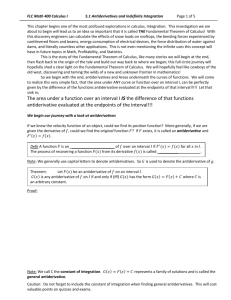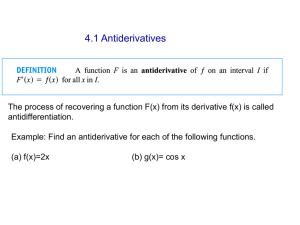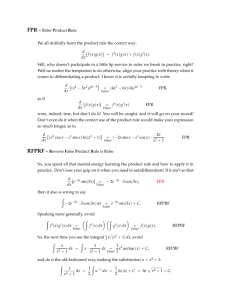
13
The Integral
Copyright © Cengage Learning. All rights reserved.
13.4
The Definite Integral: Algebraic Approach and the
Fundamental Theorem of Calculus
Copyright © Cengage Learning. All rights reserved.
Example 1 – Finding Cost from Marginal Cost
The marginal cost of producing baseball caps at a
production level of x caps is 4 – 0.001x dollars per cap.
Find the total change of cost if production is increased from
100 to 200 caps.
Solution:
Method 1: Using an Antiderivative: Let C(x) be
the cost function.
Because the marginal cost function is the derivative of the
cost function, we have C(x) = 4 – 0.001x and so
C(x) = ∫ (4 – 0.001x) dx
3
Example 1 – Solution
= 4x – 0.001
+K
cont’d
K is the constant of integration.
= 4x – 0.0005x2 + K.
Although we do not know what to use for the value of the
constant K, we can say:
Cost at production level of 100 caps
= C(100)
= 4(100) – 0.0005(100)2 + K
= $395 + K
4
Example 1 – Solution
cont’d
Cost at production level of 200 caps
= C(200)
= 4(200) – 0.0005(200)2 + K
= $780 + K.
Therefore,
Total change in cost = C(200) – C(100)
= ($780 + K) – ($395 + K)
= $385.
5
Example 1 – Solution
cont’d
Notice how the constant of integration simply canceled out!
So, we could choose any value for K that we wanted
(such as K = 0) and still come out with the correct total
change.
Put another way, we could use any antiderivative of C(x),
such as
F(x) = 4x – 0.0005x2 F(x) is any antiderivative of C(x)
whereas C(x) is the actual cost function.
or
F(x) = 4x – 0.0005x2 + 4
compute F(200) – F(100), and obtain the total change,
$385.
6
Example 1 – Solution
cont’d
Summarizing this method: To compute the total change of
C(x) over the interval [100, 200], use any antiderivative F(x)
of C(x), and compute F(200) – F(100).
Method 2: Using a Definite Integral: Because the
marginal cost C(x) is the rate of change of the total cost
function C(x), the total change in C(x) over the interval
[100, 200] is given by
Total change in cost = Area under the marginal cost
function curve
7
Example 1 – Solution
cont’d
See Figure 20.
= $385.
Using geometry or
Riemann sums
Figure 20
Putting these two methods together gives us the following
surprising result:
where F(x) is any antiderivative of C(x).
8
The Definite Integral: Algebraic Approach and the Fundamental Theorem of Calculus
In Example 1, if we replace C(x) by a general continuous
function f(x), we can write
where F(x) is any antiderivative of f(x). This result is known
as the Fundamental Theorem of Calculus.
9
The Definite Integral: Algebraic Approach and the Fundamental Theorem of Calculus
The Fundamental Theorem of Calculus (FTC)
Let f be a continuous function defined on the interval [a, b]
and let F be any antiderivative of f defined on [a, b]. Then
Moreover, an antiderivative of f is guaranteed to exist.
In Words: Every continuous function has an antiderivative.
To compute the definite integral of f(x) over [a, b], first find
an antiderivative F(x), then evaluate it at x = b, evaluate it
at x = a, and subtract the two answers.
10
The Definite Integral: Algebraic Approach and the Fundamental Theorem of Calculus
Quick Example
Because F(x) = x2 is an antiderivative of f(x) = 2x,
= F(1) – F(0) = 12 – 02 = 1.
11
Example 2 – Using the FTC to Calculate a Definite Integral
Calculate
Solution:
To use the FTC, we need to find an antiderivative of 1 – x2.
But we know that
We need only one antiderivative, so let’s take
F(x) = x – x3/3. The FTC tells us that
.
12
Applications
13
Example 5 – Total Cost
Your cell phone company offers you an innovative pricing
scheme. When you make a call, the marginal cost is
dollars per hour.
Compute the total cost of a 2-hour phone call.
Solution:
We calculate
Total Cost
14
Example 5 – Solution
cont’d
15


